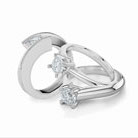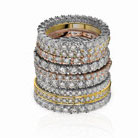Diamond Clarity
Diamond Clarity
The lack of impurities, blemishes or other identifying characteristics of a diamond define its clarity. Diamonds are unique because of their clarity characteristics since there cannot be the exact same inclusions in the same locations on two different diamonds. Major laboratories like GIA-IGI-HRD assign a clarity grade to a diamond according to five factors.
- Size: How small or large could be an inclusion within a stone?
- Number: How many are the inclusions that can be found in a diamond?
- Position: Where are the inclusion(s) located within the diamond? The inclusions located under the side facets affect the diamond’s clarity less than those located under the table or “heart”.
- Nature: Is the durability of the diamond affected by the inclusions? Large feathers can be hazardous to the durability of a diamond depending on their size and position within the diamond.
- Relief: How visible is the inclusion? There are inclusions harder to locate then other depending on how dark, white or clear there are. The dark inclusions are generally graded more harshly.
GIA Clarity Grades
Universally understood method of describing clarity grades for diamond has been provided by GIA. In the GIA-IGI-HRD report, there are five main clarity grades.
FL/IF Diamonds (flawless) are those flawless diamonds that present no inclusions under 10 x magnification. An internally flawless diamond is that which has zero or only insignificant blemishes and no inclusions when examined under 10 x magnification. Minor polishing can normally remove most blemishes. The internally flawless diamonds are very rare, beautiful and expensive.
VVS1/VVS2 Diamonds (very very slightly included) are those that contain minute inclusions and that an experienced grader would find extremely difficult to locate under 10 x magnification. This kind of diamonds is considered very rare and beautiful.
VS1/VS2 Diamonds (very slightly included) contain minor inclusions that can range from difficult to somewhat easy to see under 10x magnification. Small crystals, feathers or distinct clouds are the typical inclusions that a VS diamond can present. A VS stone can, in some rare occasion, even contain a visible inclusion such as an eye. VS Diamonds have excellent quality.
SI1/SI2 Diamonds (slightly included): An experienced gemologist can easily see inclusions of SI1/SI2 Diamonds (slightly included) put under 10 x magnification of. These inclusions can even be visible with the unaided eye but they are still of great value.
I1/I2/I3 Diamonds (included) are diamonds that present significant inclusions.
Which Clarity Grade to Choose?
When choosing a diamond, it is important to select one that doesn’t have any inclusions that could affect its overall beauty and durability. You should stick to diamonds graded “VS2” or higher if you want to stay completely clean of “eye visible” inclusions. Although very rewarding to shop for SI quality diamonds, it is best to have those diamonds reviewed, before finalizing your order, by an expert staff. Doing this will ensure the diamond you receive does not have any inclusions visible to the naked eye.
It is also a good idea that the clarity grade of your diamond and color are balanced. You should focus on the clarity grade VS2 or higher if you want diamonds in the D-F color range. Diamonds of excellent value are those in the G-I color range combined with SI clarity.



